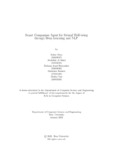| dc.contributor.advisor | Alam, Md. Golam Rabiul | |
| dc.contributor.advisor | Rasel, Mr. Annajiat Alim | |
| dc.contributor.author | Khan, Rafiur | |
| dc.contributor.author | Sohel, Abdullah Al | |
| dc.contributor.author | Shreyashee, Farhana Azad | |
| dc.contributor.author | Hossain, Shamima | |
| dc.contributor.author | Fiaz, Mahin | |
| dc.date.accessioned | 2021-09-05T06:41:39Z | |
| dc.date.available | 2021-09-05T06:41:39Z | |
| dc.date.copyright | 2021 | |
| dc.date.issued | 2021-01 | |
| dc.identifier.other | ID 16101087 | |
| dc.identifier.other | ID 19341008 | |
| dc.identifier.other | ID 16101096 | |
| dc.identifier.other | ID 17101429 | |
| dc.identifier.other | ID 16101269 | |
| dc.identifier.uri | http://hdl.handle.net/10361/14973 | |
| dc.description | This thesis is submitted in partial fulfillment of the requirements for the degree of Bachelor of Science in Computer Science and Engineering, 2021. | en_US |
| dc.description | Cataloged from PDF version of thesis. | |
| dc.description | Includes bibliographical references (pages 60-62). | |
| dc.description.abstract | Mental disorders are an unfortunate reality among the general
population nowadays. Conditions like anxiety; depression may
seem trivial on the surface but have serious consequences on an
individual’s life. These disorders have shown to be detrimental
to health and hamper a person’s general well being. In severe
cases, if mental disorders go unnoticed and untreated they can
cause permanent damage to one’s personality, drive him/her to
social isolation and in worst cases compel the person to commit
suicide as a means to end their suffering. Therefore, a need for
proper detection and awareness of such diseases in a person
emerges. Mental disorders may not show physical symptoms
in a person but it is possible to find patterns in people with
a potential mental disorder and detect them with the help
of modern Machine learning techniques. In addition to this,
such methods are completely automated and non-invasive; as
a result these systems can also help continuously monitor a
person’s mental state. We propose a system that can take
various physiological signal readings from the human body as
a way to predict distress. Upon detecting a user’s distress, the
system tries to converse with the user trained by a knowledge
base of conversations of people suffering from mental disorders
and can interact with the user in a conversation-like interface as
a companion. For this we used a system consisting of BioBERT
models(separately for questions and answers) and a couple of
FCNN layers. | en_US |
| dc.description.statementofresponsibility | Rafiur Khan | |
| dc.description.statementofresponsibility | Abdullah Al Sohel | |
| dc.description.statementofresponsibility | Farhana Azad Shreyashee | |
| dc.description.statementofresponsibility | Shamima Hossain | |
| dc.description.statementofresponsibility | Mahin Fiaz | |
| dc.format.extent | 62 pages | |
| dc.language.iso | en | en_US |
| dc.publisher | Brac University | en_US |
| dc.rights | Brac University theses are protected by copyright. They may be viewed from this source for any purpose, but reproduction or distribution in any format is prohibited without written permission. | |
| dc.subject | BioBERT | en_US |
| dc.subject | Transformer | en_US |
| dc.subject | Mental health | en_US |
| dc.subject | Machine learning techniques | en_US |
| dc.subject | Signals | en_US |
| dc.subject.lcsh | Deep Learning | |
| dc.title | Smart companion agent for mental well-being through Deep Learning and NLP | en_US |
| dc.type | Thesis | en_US |
| dc.contributor.department | Department of Computer Science and Engineering, Brac University | |
| dc.description.degree | B. Computer Science | |

